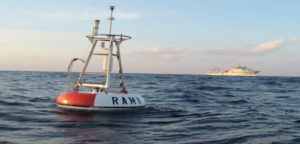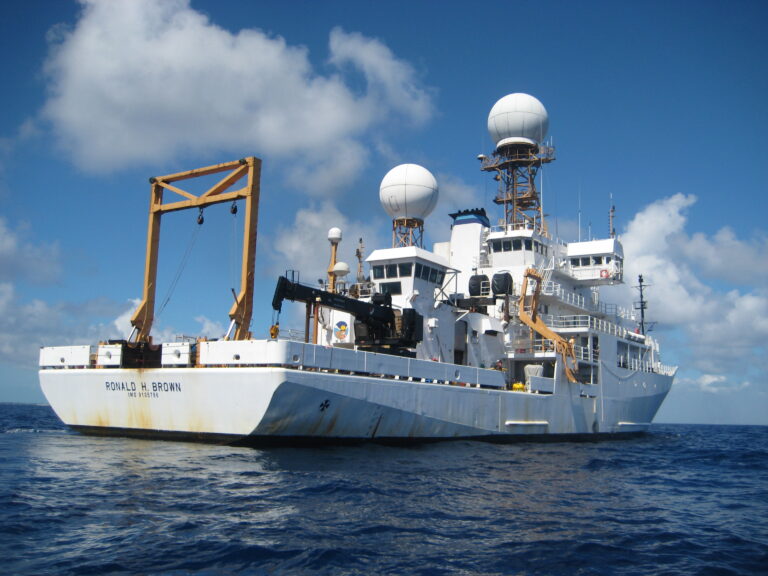MTI reports on NOAA’s latest global mission to help improve our understanding of the ocean’s profound effects on the weather
In February 2018, NOAA’s largest oceanographic research vessel, NOAA Ship Ronald H Brown, set off on a voyage that would last 243 days and take the ship and its crew nearly 44,289 miles (71,276km), with port calls in South Africa, the Seychelles, India, Australia and Hawaii.
The purpose of the eight-month voyage was to conduct scientific research and service buoys that inform global weather, climate and ocean forecasting. “Despite numerous technological advances over the past few decades, ship-based hydrography remains the only method for obtaining high-quality, high-resolution spatial and vertical measurements of a suite of physical, chemical and biological parameters over the full water column,” explains Dr Sidney Thurston, RAMA program manager, part of Overseas Program Development for NOAA’s Ocean Observation and Monitoring Division at NOAA’s Climate Program Office.
As part of the trip, NOAA ship Ronald H Brown completed sampling of the GO-SHIP IO7N repeat hydrography line, part of the wider Global Ocean Ship-based Hydrographic Investigations Program (GO-SHIP). GO-SHIP brings together scientists with interests in physical oceanography, the carbon cycle, marine biogeochemistry and ecosystems, plus other users and collectors of ocean interior data, and coordinates a network of globally sustained hydrographic sections as part of the global ocean/climate observing system.
Thurston says, “The cruise, which departed from Durban, South Africa, on April 23, sampled a GO-SHIP transect in the western Indian Ocean. This was the first scientific occupation of the line IO7N section since 1995. The overall goal of the cruise was to learn how the western Indian Ocean has changed over the past 23 years. Specifically, has the deep ocean warmed? Have the regional concentrations of dissolved oxygen, carbon dioxide and nutrients changed? Has the western Indian Ocean become more acidic? One of the key objectives of the cruise was to measure the heat stored in the ocean.
“Existing observations from various platforms show that the upper-ocean heat content for the World Ocean has been steadily increasing since the 1970s. The Indian Ocean is the fastest warming ocean on the planet and its upper 2,000m [6,500ft] heat content has also been increasing. But has the excess heat penetrated deeper than 2,000m in the western Indian Ocean? The data collected on this cruise will help to answer this question.”
In addition to the core conductivity temperature depth (CTD) measurements and chemical observations, state-of-the-art bio-optical measurements were made along the transect to characterize biological processes and link them to satellite ocean color measurements. “These measurements included phytoplankton pigments, phytoplankton and zooplankton species composition, primary production and fluorescence/light response,” Thurston says.
The data will be used to describe the phytoplankton community structure across biogeographic regimes delineated using the core CTD and chemical observations and will also be used to help improve satellite remote sensing estimates of chlorophyll concentration, primary production and phytoplankton community size and structure. “The cruise was a resounding success. The IO7N line was completed on schedule and all major scientific objectives were met,” continues Thurston.
Port calls

The Ronald H Brown made several stops during its trip, the most important of which was in Goa, India. The stop was made to load Research Moored Array for African-Asian-Australian Monsoon Analysis and Prediction (RAMA) moorings for deployment at three new sites in the Arabian Sea and service existing RAMA moorings in the Indian Ocean. It also coincided with the Earth Observations and Science for Society and Economy colloquium, which brought together 20 US and 200 Indian scientists to advance ocean observations used to improve climate, weather and fisheries prediction.
“To underline the importance of the US-Indian science collaboration, NOAA arranged for the Ronald H Brown to arrive in Goa’s nearby port of Mormugao to participate in the colloquium and welcome local schoolchildren on board for a World Oceans Day tour,” Thurston says. “At the end of the colloquium, NOAA and Indian scientists set off on the Brown to launch three buoys in the Indian Ocean observing system. The buoys will be moored in the Arabian Sea, an area where little data has been collected. Closing this data gap is expected to make the Indian Ocean observing system even more valuable to both nations and the world.”
Another important stop was in Darwin, where the Australian Institute of Marine Science (AIMS) met with members of NOAA. According to Thurston, the two research bodies have a close relationship of more than 30 years under a Memorandum of Understanding to work together on areas of common interest.
“AIMS scientists were using information on large-scale ocean changes, such as that delivered by NOAA, to better understand the local implications of a warming ocean,” Thurston continues. “The Ronald H Brown has been conducting marine observation science in the Indian Ocean, to better understand the Indian Ocean’s role in global cycles and monsoon prediction. Large-scale ocean observation is a focus for NOAA, which is part of a coordinated international ocean observing program to which Australia also contributes.
“NOAA’s broader research supports AIMS’s deployment of ocean sensors across northern Australia to measure coastal sea temperatures to better understand how local changes impact coastal conditions and ecosystems. In a warming climate some of the most dramatic ecosystem changes have been associated with extreme heatwaves. AIMS and NOAA are collaborating on a coastal mooring observations white paper, which aims to improve regional and national coordination.”
RAMA maintenance
The Ronald H Brown departed Goa on June 14 to establish three RAMA sites in the Arabian Sea along 65E and 67E and maintain five existing RAMA moorings along 67E. “RAMA was designed to study the Indian Ocean’s role in monsoons,” explains Thurston. “One-third of the world’s population depends on monsoon-driven rainfall for agricultural production, so improving our understanding and ability to predict monsoons has been a long-standing objective of the international scientific community,” he adds.
Data from the RAMA moorings will be used to better understand the Madden-Julian Oscillation phenomenon, named after Rolland Madden and Paul Julian, the two scientists who discovered it in the 1970s. “It starts when water vapor rises out of the Indian Ocean every 30 to 60 days to create a major ocean storm that travels west to east from near the Seychelles off Africa toward India, crosses into the tropical Pacific Ocean, and eventually affects weather patterns across the nation,” Thurston explains. “The weather phenomenon influences everything from monsoons in India to heatwaves and flooding in the USA, and these buoys are at the heart of detecting it, providing measurements that NOAA depends on for US weather prediction two to four weeks out.”
During the voyage, scientists were tasked with carrying out maintenance on some of the existing RAMA buoys. There are several challenges with regard to maintaining the highest standard of data quality in the RAMA network, according to Thurston, with one of the major issues being ship availability. “Specialized ships with deep-sea mooring capabilities are required for retrieval and deployment operations. The buoys should be recovered and redeployed at least once a year to ensure continuous data transmission,” Thurston comments.
Vandalism of buoys is a problem that has been raised in global forums, including the Intergovernmental Oceanographic Commission, the UN General Assembly, the Western and Central Pacific Fisheries Commission, and the Indian Ocean Tuna Commission. “Tampering with buoys, both deliberate and accidental, and problems linked with fishing, are major threats to the existence of buoy networks in the open ocean,” Thurston comments. “Moreover, vandalism causes the loss of significant scientific data collected by buoys.
“Another major challenge is overcoming sensor fouling to ensure that reliable data is provided. The anti-fouling methods adopted for the open ocean environment can ensure good quality data. Another principal constraint is the lifetime of batteries to power the electronics on the buoy. This technology has also been extended during the RAMA program in the Indian Ocean,” he adds.
After successfully completing the Ronald H Brown 2018 Indian Ocean Multidisciplinary expedition, the research vessel serviced similar ocean moorings, known as TAO (Tropical Atmosphere Ocean) in the Pacific Ocean. On October 23, the Ronald H Brown returned to its home port in Charleston, South Carolina. “In my opinion, the 2018 Ronald H Brown Multidisciplinary Indian Ocean Expedition was NOAA at its best, shining its bright light around the world to make our planet a better place by reaching out to India’s next generation of oceanographers and meteorologists and scientists across the Indian Ocean region,” concludes Thurston.
This article first appeared in the April 2019 issue of Meteorological Technology International magazine.



